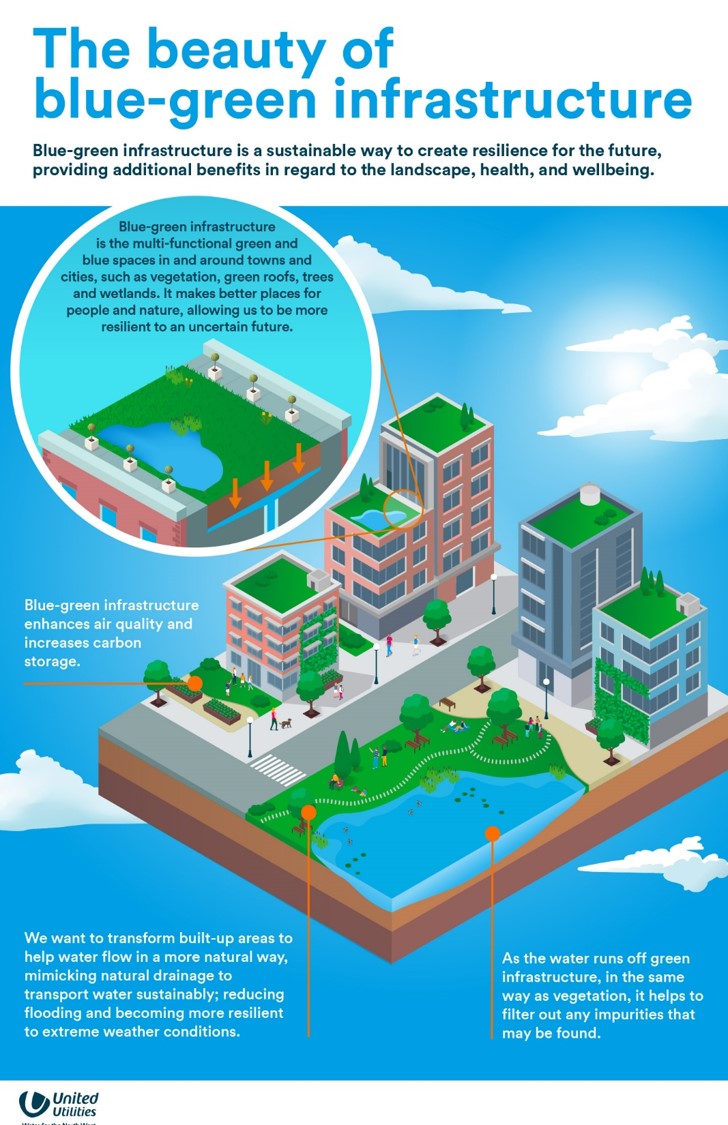Blue-green infrastructure
The beauty of blue-green infrastructure
It probably won’t come as much of a surprise that here in the UK it rains a lot. In fact, it rains 133 days a year in the UK on average and 184 days a year here in the North West – that amounts to a whopping 810mm! But, where does all this rain go?
Roads and pavements in our towns and cities, mean that the natural flow of water drainage is reduced. We’re looking to transform these built-up areas to help water flow in a more natural way, mimicking natural drainage to help us transport water sustainably.
For this reason, we need to explore options in collaboration with partners such as the Environment Agency, Lead Local Flood Authority, and Developers, and manage the water that interacts with our sewers and drains.
Grey infrastructure is what has been used for many years and while the likes of dams, pipes, and treatment works provide highly effective solutions to the management of water, we want to see more natural, resilient, and sustainable solutions that protect against development and climate change. That’s not to say that it is always the wrong option, but when possible, we’re exploring other options which are more environmentally friendly.
Enter blue-green infrastructure. With the increased changes in weather patterns and the enhanced need to restore our urban environments to more environmental places, blue green infrastructure is the most sustainable way to create resilience for the future, providing additional benefits in regard to the landscape, health, and wellbeing.
There are a number of different types of blue-green infrastructures. But why do we use them? Let’s take a look.
What is blue-green Infrastructure?
Blue-green infrastructure can be defined as a strategically planned network of natural and semi-natural areas with other environmental features designed and managed to deliver a wide range of ecosystem services (COM,2013). It incorporates green spaces (vegetation-based components such as trees, hedgerows, and permeable paving) and water based blue solutions (ponds, wetlands, and flood plains) to achieve this. The output is being able to mimic natural drainage systems through these interventions which manage rainfall and water much more effectively than traditional urban environments.
For example, blue infrastructure can be used to manage water by directing and storing it underneath trees in urban environments. This component reduces the likelihood of flooding. The green element of this solution uses trees above the storage to draw up water, improving the water quality and creating more green and leafy spaces that store carbon dioxide, release oxygen, and capture harmful pollutants.
Where is blue-green infrastructure most needed?
When we think about where blue-green infrastructure is most desirable we must think about where is susceptible to flooding – which is most commonly within towns and cities. Urban areas are where creep rates (where permeable surfaces get changed to impermeable surfaces) are highest. Examples of urban creep are where driveways are changed from grass or gravel to impermeable draining flags or bricks.
The undeniable benefits of blue-green infrastructure
Blue-green infrastructure can replace or enhance grey infrastructure solutions. Blue-green infrastructure improves our drainage capacity by taking water out of the combined sewer network where possible, reducing spills of storm sewage to the environment. By delivering blue-green infrastructure we are not only delivering the primary output of the scheme to reduce flood volume but we are making catchment of the future more sustainable through operating and maintaining more efficient networks which contain less rainfall that are more resilient to extreme weather.
Improved water quality is something we’re committed to at United Utilities and these solutions help us ensure that our customers continually benefit in this regard.
As the water runs off green infrastructure like vegetation it helps to filter out any impurities that may be found in the water.
Improved public health is one area where blue-green infrastructure has really come into its own in 2020. The recreation and social opportunities created by blue-green infrastructure provide much-needed benefits for both mental and physical health, alongside contributing to tourism too.
While blue-green infrastructure has successfully positioned itself as a sustainable solution to flood managing water in urban areas, it also delivers an additional benefit in its ability to cool water and mitigate the effects of urban heat islands – areas densely populated by human activity that generate considerably more heat. Blue-green infrastructure successfully improves the situation, enhancing air quality and increasing carbon storage.
There are many different reasons why we at United Utilities want to use blue-green infrastructure throughout the catchment and why we will continue to do so into the future, benefiting not only water, but people and wildlife too.
CaST and blue-green infrastructure
So, now we’ve discussed what blue-green infrastructure is and why we’re so keen to use it across the North West, it’s worth exploring how they relate to a catchment system thinking. CaST is an approach to water management that we’re carrying out across the region and involves looking at the impact of our activities, not just in regard to water, but everyone and everything which interacts with it. Blue-green infrastructure, providing more sustainable alternatives aligns perfectly with a catchment systems thinking approach.
Bloc Smart Blue-Green Roof
United Utilities has co-funded a blue-green roof on Bloc, a city centre workspace, to help develop our understanding of how storing and re-using rainwater at a roof level can reduce the volume of surface run-off entering the sewer network. As a result it will help to lower the flood risk associated with the prolonged high-intensity storm events that are becoming increasingly frequent as the climate changes.
Catchment Systems Thinking
Watch our video to learn more about Catchment Systems Thinking.
